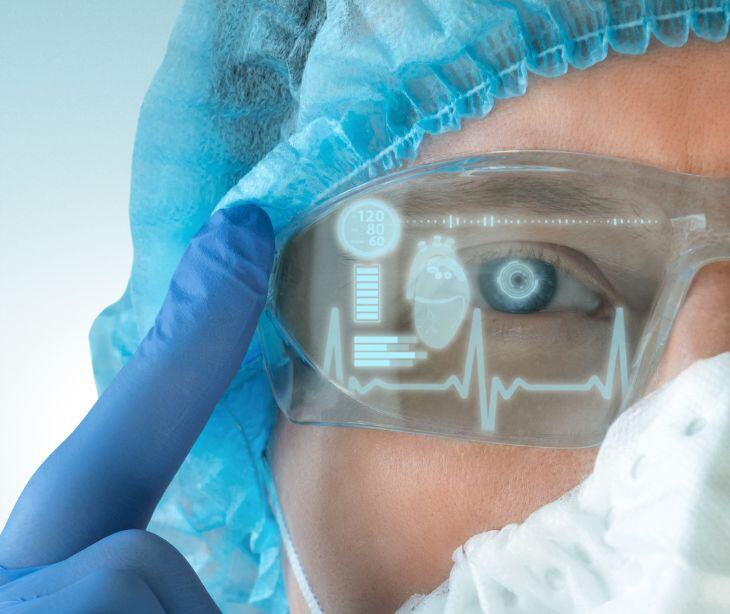
Over the years, there has been a consistent rise in the number of active augmented reality (AR) user devices. In 2019, an estimated 0.44 billion AR user devices were actively being used, while by 2021, this figure had nearly doubled to about 0.81 billion. As of 2023, around 1.4 billion such devices are actively operational for users worldwide. So what is augmented reality?
Understanding augmented reality
Augmented reality (AR) is a technology that overlays digital information—such as images, videos, and data—onto the real world in real time. Unlike virtual reality (VR), which creates a completely immersive virtual environment, AR enhances the user's perception of the real world by adding virtual elements to it. This is achieved through devices such as smartphones, tablets, AR glasses, and headsets.
Read also: The healthcare digital transformation
Components of augmented reality
Hardware
- Displays: Devices like smartphones, tablets, AR glasses, and headsets display augmented elements.
- Sensors: Cameras, GPS, accelerometers, and gyroscopes help the device understand the user's environment and movements.
- Processors: Powerful processors are required to handle the real-time data processing and rendering of virtual objects.
Related: What is a mobile device management system?
Software
- AR platforms: Frameworks and tools like ARKit (Apple), ARCore (Google), and UtilityAR allow developers to create AR applications.
- Computer vision: Techniques that enable the device to recognize and track objects and environments in the real world.
- 3D modeling: The creation of 3D digital objects that can be superimposed onto the real world.
How augmented reality works
- Tracking and registration: AR systems use sensors and computer vision algorithms to detect and track the position and orientation of physical objects in the user's environment. This is known as "registration," ensuring that the digital content is accurately aligned with the real world.
- Rendering: Once the system knows the position of the user and the objects, it renders the digital content and overlays it in the real world. This requires real-time processing to ensure the augmented elements move and change perspective as the user moves.
- Interaction: Users can interact with the AR content through touch, gestures, voice commands, or other input methods, depending on the device and application.
Applications of augmented reality
- Healthcare: Enhancing medical training, providing surgeons with critical information during operations, and aiding in patient rehabilitation and education.
- Education: Offering interactive and immersive learning experiences for students in subjects like anatomy, astronomy, and history.
- Gaming and entertainment: Creating immersive gaming experiences and interactive media content.
- Retail: Enabling virtual try-ons and visualizations of products in real-world settings.
- Manufacturing and maintenance: Assisting workers with real-time information and instructions, improving accuracy and efficiency.
- Real estate: Allowing potential buyers to take virtual tours of properties and see how spaces can be used or customized.
See also: HIPAA Compliant Email: The Definitive Guide
Benefits of augmented reality
- Enhanced user experience: AR provides more engaging and interactive experiences by blending digital content with the real world.
- Improved learning and training: AR can make complex information more accessible and understandable.
- Increased efficiency: In fields like manufacturing and healthcare, AR can streamline processes and reduce errors.
- Better visualization: AR helps users visualize changes and outcomes, aiding in decision-making processes.
Challenges of augmented reality
- Technical limitations: Developing robust AR applications requires advanced hardware and software, which can be costly and complex.
- User adoption: Some users may be hesitant to adopt AR technology due to unfamiliarity or discomfort with new devices.
- Privacy and security: AR applications often require access to cameras and other sensors, raising concerns about data privacy and security.
- Content creation: Developing high-quality, accurate AR content can be time-consuming and expensive.
FAQs
How is AR different from Virtual Reality (VR)?
AR overlays digital content on the real world, enhancing the user's current environment, while VR creates a completely immersive digital environment that replaces the real world. AR allows users to interact with both real and virtual elements simultaneously.
Learn more: The transformation of healthcare through virtual reality
How secure is AR in terms of data privacy?
Ensuring data privacy and security in AR applications is crucial, especially in healthcare. AR systems must comply with regulations such as HIPAA in the U.S. and GDPR in Europe to protect sensitive patient information.
Subscribe to Paubox Weekly
Every Friday we'll bring you the most important news from Paubox. Our aim is to make you smarter, faster.



